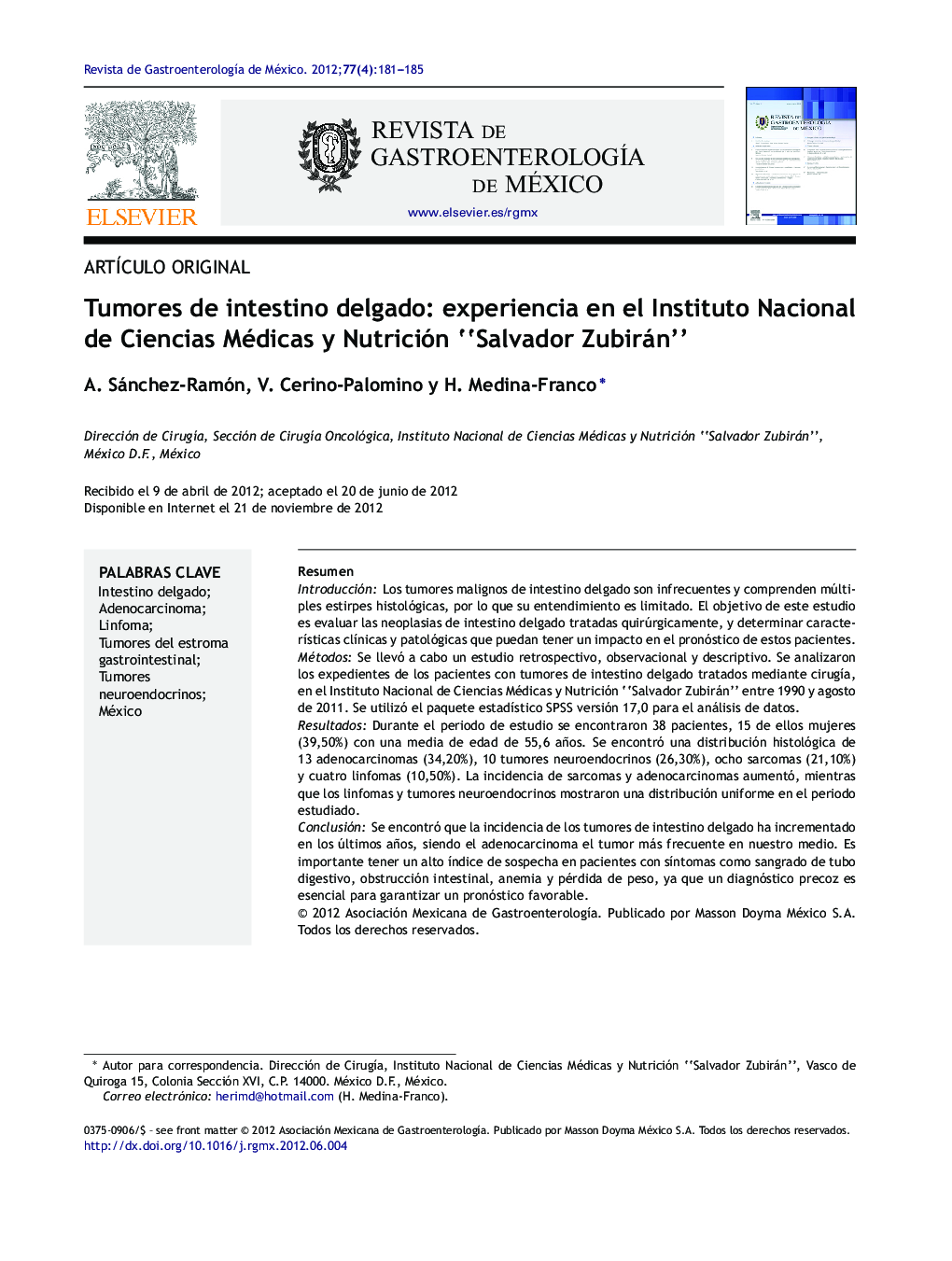| Article ID | Journal | Published Year | Pages | File Type |
|---|---|---|---|---|
| 3318909 | Revista de Gastroenterología de México | 2012 | 5 Pages |
ResumenIntroducciónLos tumores malignos de intestino delgado son infrecuentes y comprenden múltiples estirpes histológicas, por lo que su entendimiento es limitado. El objetivo de este estudio es evaluar las neoplasias de intestino delgado tratadas quirúrgicamente, y determinar características clínicas y patológicas que puedan tener un impacto en el pronóstico de estos pacientes.MétodosSe llevó a cabo un estudio retrospectivo, observacional y descriptivo. Se analizaron los expedientes de los pacientes con tumores de intestino delgado tratados mediante cirugía, en el Instituto Nacional de Ciencias Médicas y Nutrición “Salvador Zubirán” entre 1990 y agosto de 2011. Se utilizó el paquete estadístico SPSS versión 17,0 para el análisis de datos.ResultadosDurante el periodo de estudio se encontraron 38 pacientes, 15 de ellos mujeres (39,50%) con una media de edad de 55,6 años. Se encontró una distribución histológica de 13 adenocarcinomas (34,20%), 10 tumores neuroendocrinos (26,30%), ocho sarcomas (21,10%) y cuatro linfomas (10,50%). La incidencia de sarcomas y adenocarcinomas aumentó, mientras que los linfomas y tumores neuroendocrinos mostraron una distribución uniforme en el periodo estudiado.ConclusiónSe encontró que la incidencia de los tumores de intestino delgado ha incrementado en los últimos años, siendo el adenocarcinoma el tumor más frecuente en nuestro medio. Es importante tener un alto índice de sospecha en pacientes con síntomas como sangrado de tubo digestivo, obstrucción intestinal, anemia y pérdida de peso, ya que un diagnóstico precoz es esencial para garantizar un pronóstico favorable.
BackgroundMalignant tumors of the small bowel are uncommon and include multiple histologic strains, which helps explain the existing limited understanding of them. The aim of this study was to evaluate surgically treated small bowel tumors and to determine the clinical and pathological characteristics that can have an impact on patient outcome.MethodsA retrospective, observational, and descriptive study was carried out. The case records of patients with small bowel tumor that were surgically treated at the Instituto Nacional de Ciencias Médicas y Nutrición “Salvador Zubirán” from 1990 to August 2011 were analyzed using the SPSS version 17.0 statistical package.ResultsThirty-eight small bowel tumor patients were found that had been operated on within the time frame studied. Fifteen of them were women (39.50%) and 23 were men (60.50%), and the mean age was 55.6 years. The histologic distribution was 13 adenocarcinomas (34.20%), 10 neuroendocrine tumors (26.30%), 8 sarcomas (21.10%) and 4 lymphomas (10.50%). There was an increase in the incidence of sarcomas and adenocarcinomas, whereas lymphomas and neuroendocrine tumors were evenly distributed.ConclusionsAn increase in small bowel tumor incidence in the last few years was observed and adenocarcinoma was the most frequent tumor in the study population. It is important to have a high degree of suspicion for this disease when patients present with symptoms such as gastrointestinal bleeding, bowel obstruction, anemia, and weight loss, because early diagnosis is essential for guaranteeing favorable outcome.
